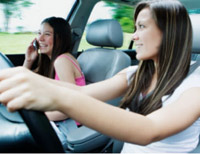
Texting while driving, by Flickr user ericathompson
If you're a parent, it's probably not for the reasons you might think of—like beer, testonerone-fueled horseplay, and more beer.
A new analysis from the Texas Transportation Institute, examining ten years of highway fatalities, from 1999 through 2008, and finds that for teens, the chances of a fatality when driving after dark are more likely than those alone of drinking, speeding, or not wearing a seatbelt.
The study covered a period in which overall traffic deaths declined, thanks largely to improvements in automotive and highway safety. Yet nighttime deaths didn't drop; they actually rose 7.5 percent for those aged 20-69 and 10.2 percent for those 16-19—a significant increase given all the other safety improvements we've made in the past decade.
All the safety improvements, that is, except for the missing link that might help explain that increase in deaths: those distracting hand-held devices we all carry that became so common during the period of the study.
The study's authors pointed to the combination of cellphone-related distraction and nighttime visibility as particularly deadly. “Being on a cell phone behind the wheel impairs our driving ability,” said Russel Henk, a senior research engineer at TTI. “When you add the nighttime danger, you create the perfect storm, and that storm is much more severe for young drivers, largely because of their lack of driving experience.”
While alcohol involvement increased for those 20 and older, it decreased slightly for teens.
Younger drivers do have better night vision and are more likely to spot hazards in the dark ahead, but there are clearly other distraction-related reasons for the spike; teens are also probably more likely to be holding one of those distracting devices while behind the wheel.
The study cited cellphone use—including its rapid technological advancement and increased affordability—as "the most notable new driving risk factor for contemporary teens."
With three teens in a vehicle, the chances of a crash are six times what they would be with only the driver aboard, a TTI researcher told the Washington Post.

U.S. lawmakers to get tougher on teen drivers
Several U.S. Senators have introduced legislation aimed at unifying the rules, which vary widely from state to state, regarding when drivers can get a learner's permit and when that license becomes unrestricted. At this time, there are 42 states that permit teens under 16 to get a learner's permit and seven states that allow a learners permit at 14.
Many of these rules date back decades ago to a time when it was more common for teens to be expected to work—on a family farm, for instance.
The new federal rules would feature three graduated stages of licensing; in the first two, both unsupervised night driving and cellphone use, in any way, wouldn't be allowed.
So-called graduated licensing (GDL) programs have been shown to work. In Massachusetts, there was a 75-percent drop in fatal crashes involving drivers under 18 in the three years following new restrictions for young drivers, according to the Insurance Institute for Highway Safety, and injury crashes for drivers in that age group fell by 38 percent.
But a lot of the responsibility rests on parents—to set limitations on both car use and cellphone use, and how many friends they can have aboard, and stick to them.
For a summary of your state's nighttime trends and how they relate to the national ones, you'll want to check out the TTI's Teens in the Driver's Seat site, or for more details, the full report.
[Washington Post; Texas Transportation Institute; USA Today]
